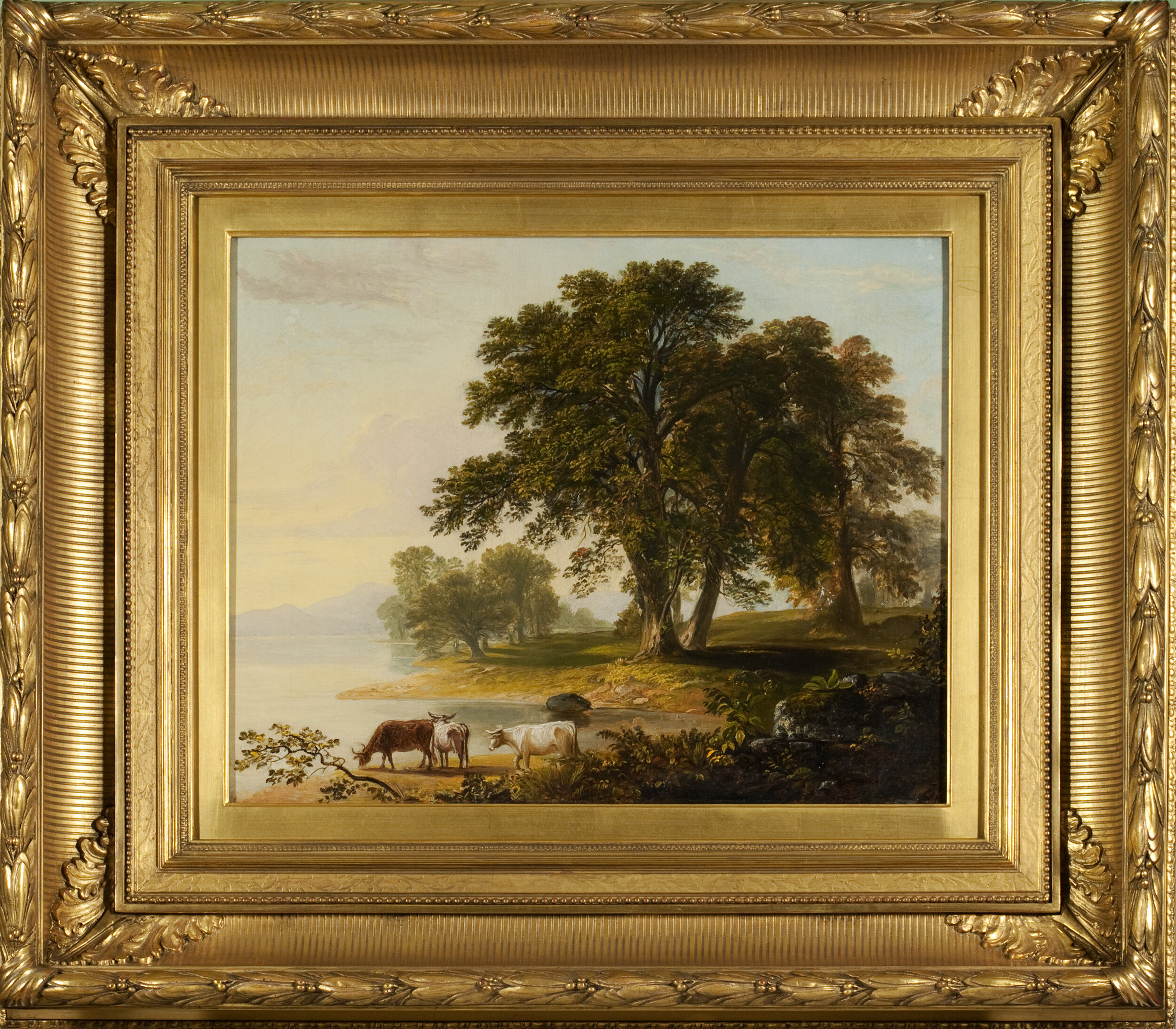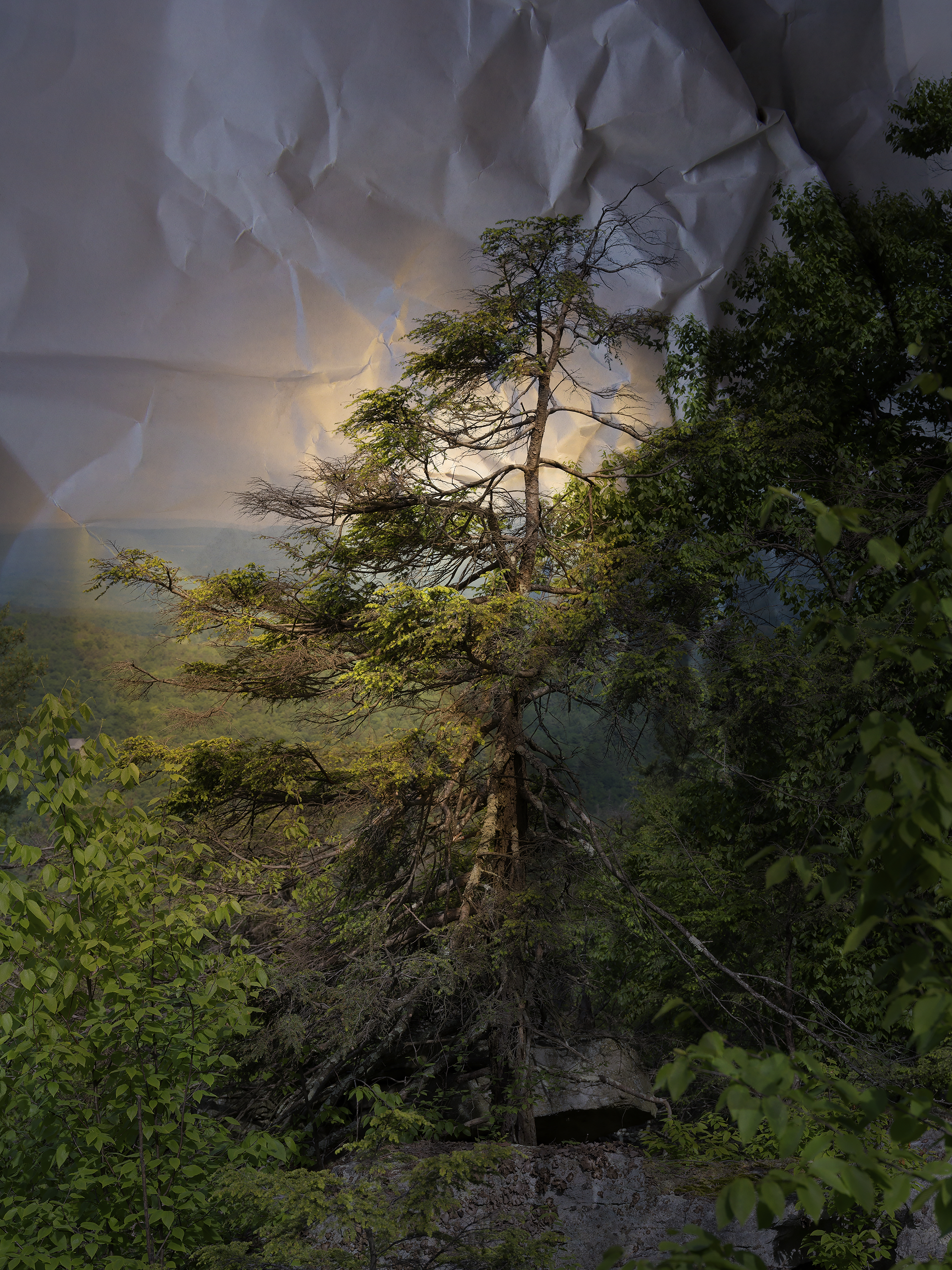2019 Exhibit | Photo + Synthesis
October 12 to December 21, 2019 Hudson, New York
LightField acknowledges that the landscape art in this exhibit represents stolen tracts of the original inhabitants of this area: Mohican, Catskill Munsee, Esopus Munsee, and Wappinger tribes. Our 2024/25 exhibit will focus on Native artists whose practices call on landscape to summon heritage and memory, mystery and self-knowledge. We will let you know more as it develops!
For our 2019 exhibit, LightField Arts has chosen seven artists to make or exhibit work focusing on the Hudson River Valley and climate change.
© Pastoral Scene at Lake’s Edge, circa 1865, Asher Brown Durand
The show draws a geographic line around the Hudson River Valley. In part this is to prompt a fresh look at the mythology of the Valley’s art, ecology, and history, but through the lens of our Anthropocene era. Works on exhibit include contemporary landscape photography, mid-19th century landscape painting, and data visualization art about tree ring science.
Participating artists contribute newly commissioned and existing work by: Sarah Bird, Christopher Griffith, Genevieve Hoffman, Tanya Marcuse, Daniel McCabe, Laura Plageman, and two paintings by Asher B. Durand, leader of the Hudson River School.
Alongside these works, LightField exhibits the art produced in its annual Young Photographers Workshop.
Artists of the Hudson River School were alarmed about the severe deforestation and industrialization underway in the Hudson River Valley. Their paintings helped spark America’s conservationist impulses, and helped knit the fragile cultural union that kept America whole past the Civil War.
Jump to today, an equally polarized time, politically and culturally. Tree scientists use the Hudson River Valley for climate change research because it is a living biome that is home to one of the most diverse tree populations on the planet, and because it still holds 400-year-old trees.
Commissioned Artists
LightField Arts has commissioned new work centered on the Hudson River Valley from photographers and artists Sarah Bird, Christopher Griffith, Genevieve Hoffman, and Laura Plageman. Their original, new art will be in part informed by partnerships with the Lamont Doherty Tree Ring Lab.
© Sarah Bird, Heritage Redwood
SARAH BIRD
Contemporary photographer Sarah Bird, an American artist, will re-imagine landscapes in the Hudson River Valley as inspired by the Hudson River School of Art.
Sarah Bird is an interdisciplinary artist whose work investigates relationships between humans and the natural world in an attempt to catalyze us to protect our planet’s precious bio-diversity. Bird’s current photographs focus on trees, elevating them to their essential place in our web of being, and reveal the beauty and biological wealth of these great protagonists of the living world. The portraits restore the tree to the place from which it had been stripped by anthropocentrism. Her work is informed by Deep Ecology of the 1970s, recent scientific discoveries concerning trees’ relationships among other plant and insect species, and trees’ vital role in carbon sequestration. She is based in Brooklyn, NY and Santa Cruz, CA.
© Christopher Griffith, Rings, 2019. From the Lamont Doherty Earth Observatory Tree Ring Lab.
CHRISTOPHER GRIFFITH
Contemporary photographer Christopher Griffith will highlight landscape details of the Hudson River Valley in order to strip away “story” and allow structural features to take center stage.
Born in Canada and raised in Boston, Massachusetts, Christopher Griffith is a commercial and art photographer who has gained both critical and commercial success for his clean, minimalist approach and intense graphic imagery. Monographs include STATES (Powerhouse 2000); FALL (Powerhouse 2004) a macro analysis of the stunning show of colour and texture in Autumn leaves; and BLOWN (Auditorium Editions 2009), an abstract study of blown out tire treads collected from the highways of America. Christopher balances his time between steady work in the advertising world (clients include American Express, Maserati, Deutsche Bank, and Sony), and personal art projects. His books have won a variety of awards from D&AD, Art Directors Club, Communication Arts and Graphis. He lives with his family in a Dutch barn in upstate New York.
GENEVIEVE HOFFMAN, HEMLOCK TREE RING DATA, 2019
This data visualization takes raw tree ring growth of a real eastern hemlock (Tsuga canadensis) as it adds wood to its base for 421 years. The actual tree this visualization is based on was “born” in 1579 at Mohonk Preserve in the Hudson River Valley. The data was originally collected via a core sample in 2000 by Paul Krusic of the University of Cambridge, and interpreted by Neil Pederson, a tree researcher at Harvard Forest. Additional data was provided by the US National Forest Service.
Hemlocks are a foundational species whose nickname, the “redwood of the east,” hints at their unique ecological functions. A hemlock can live 500 years and reach 170 feet. Almost 100 bird species use hemlocks to nest and rest. Humans use its bark and needles for its astringent and healing properties to treat arthritis, colds, coughs, fever. Today, hemlocks face a real adversary: the hemlock woolly adelgid beetle (HWA), which threatens the Hudson Valley region. Estimates have hemlocks functionally extinct in the Hudson Valley in ten years.
Genevieve Hoffman is an artist and designer working at the intersections of research, data, science, sustainability and design. She is especially concerned with the planned obsolescence built into the disposable culture of our digital era, as well as the relationship between technology and the natural resources that make it possible. Recently, she has been exploring non-monetary currencies, the forces and interrelated systems of the global economy, and the infrastructure that makes it all run. She has spoken about and presented her work at various institutions, including the Rhode Island School of Design (RI), University of Georgia (GA), SUNY Stonybrook (NY), New York Hall of Science(NY), School of Visual Arts (NY), New York University (NY), and the University of Buffalo (NY). She recently completed a research residency at the Interactive Telecommunications Program at NYU, where she received a Master's degree in Research Arts.
© Laura Plageman, Hemlock, Mohonk Preserve, NY 2019
LAURA PLAGEMAN
Landscape photographer Laura Plageman will respond to landscapes of the Hudson River Valley to play with photographic truth and distortion. She is interested in making pictures that examine the natural world as a scene of mystery, beauty, and constant change — transformed both by its own design and human presence.
Laura Plageman is an artist and educator who lives and works in Oakland, CA. Her work has been exhibited in galleries and institutions across the United States and internationally. She earned a BA at Wesleyan University (Middletown, CT) and an MFA from the California College of the Arts (San Francisco, CA).
Featured Artists
Other participating artists will exhibit photography about the purity (and not) of landscape, botany, and taxonomy—subjects whose roots go back to the very beginnings of photography.
© Tanya Marcuse, Woven No 16
TANYA MARCUSE, WOVEN
In the series Woven, Marcuse imagines herself introducing time into the lush flora and fauna which make up the millefleurs backgrounds of medieval tapestries. The 5 x 10 foot photographs sometimes take weeks to compose, and during this process of composition, of collecting, arranging, burning, painting, and transplanting, there is change. Flowers wither, spiders build webs, new shoots emerge, and corpses decay. Influenced both by the Dutch vanitas tradition and the allover compositions of Jackson Pollock, she hopes the photographs can be experienced as detailed still lives when viewed from up close, but hold together as immersive, more abstract compositions from further away. Common to all the pieces is a sense of plenty which verges on plunder.
Tanya studied Art History and Studio Art at Oberlin and earned her MFA from Yale. In between, on a year-long Thomas J. Watson Fellowship she lived in the rainforest with a small group of Indians, photographing and writing. Her photographs are held by the Metropolitan Museum of Art, the San Francisco Museum of Modern Art, and the George Eastman Museum, among others. In 2002, she received a Guggenheim fellowship to pursue her project Undergarments and Armor. In 2005, she embarked on a three-part, fourteen-year project, Fruitless | Fallen | Woven, moving from iconic, serial photographs of trees in Fruitless to lush, immersive, allegorical works in Fallen and Woven. Tanya is a student of martial arts and boxing as a method of cultivating mental and physical concentration and discipline. Tanya’s latest book is the three-part Fruitless | Fallen | Woven (Radius Press, 2019).
© Daniel McCabe, Platte Clove, NY, 2019
Daniel McCabe is a New York-based filmmaker and photographer. His work has appeared in National Geographic, The New York Times, Time Magazine, BBC, Al Jazeera and CNN among other outlets. Daniel’s first feature-length documentary film THIS IS CONGO premiered at the prestigious 74th Venice Biennale and has won numerous awards worldwide. He continues to work in both still and moving image and is currently in production on projects in Uganda, Sudan, Mali and the Democratic Republic of the Congo.






